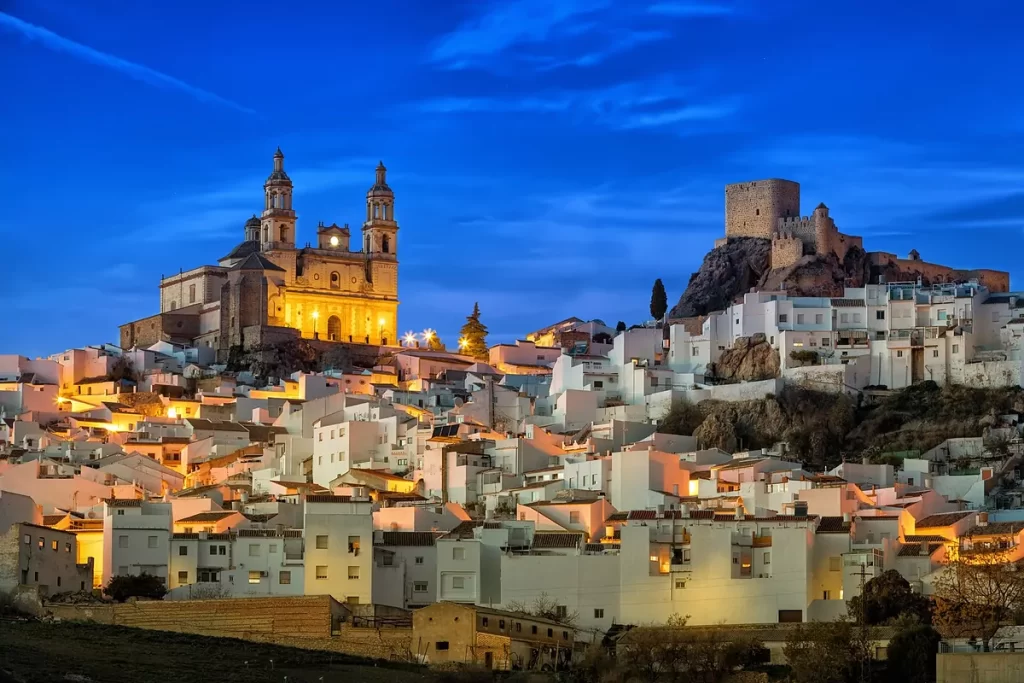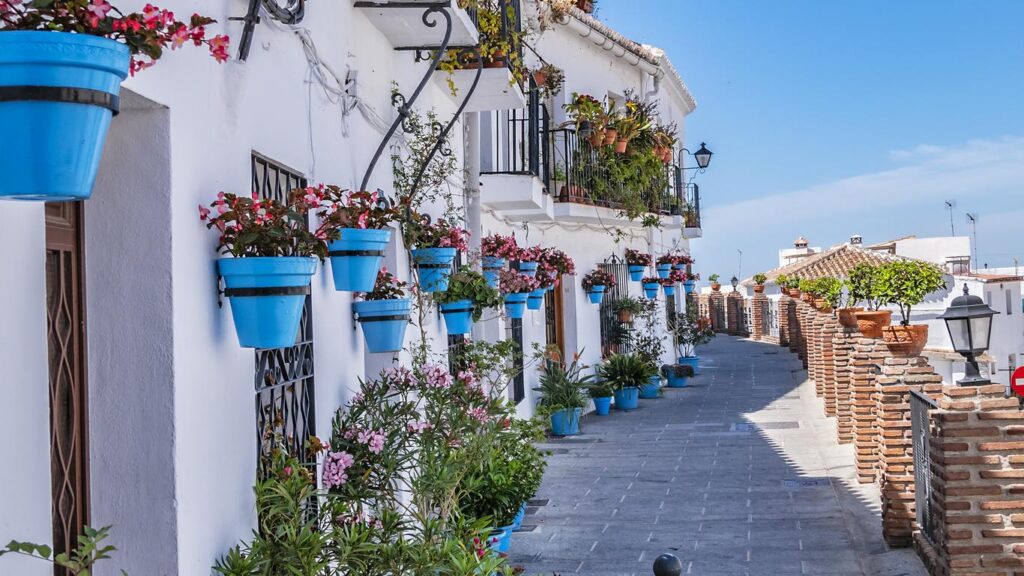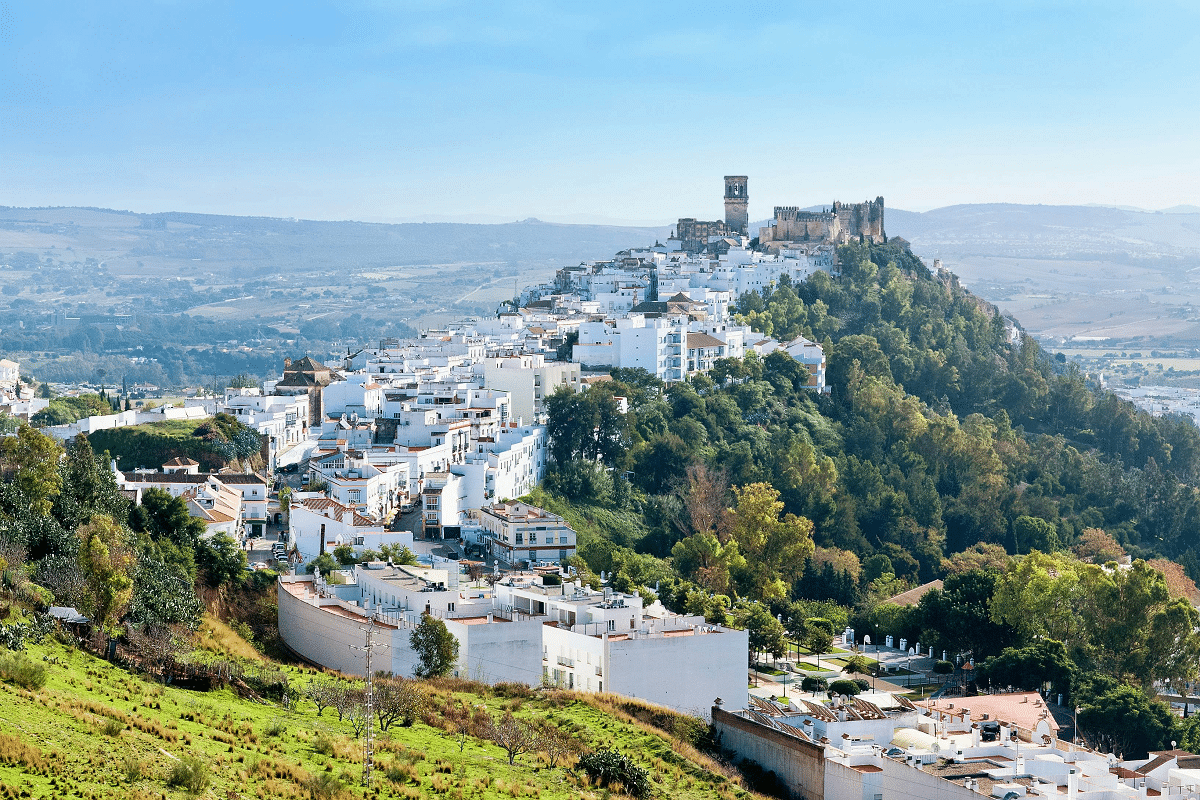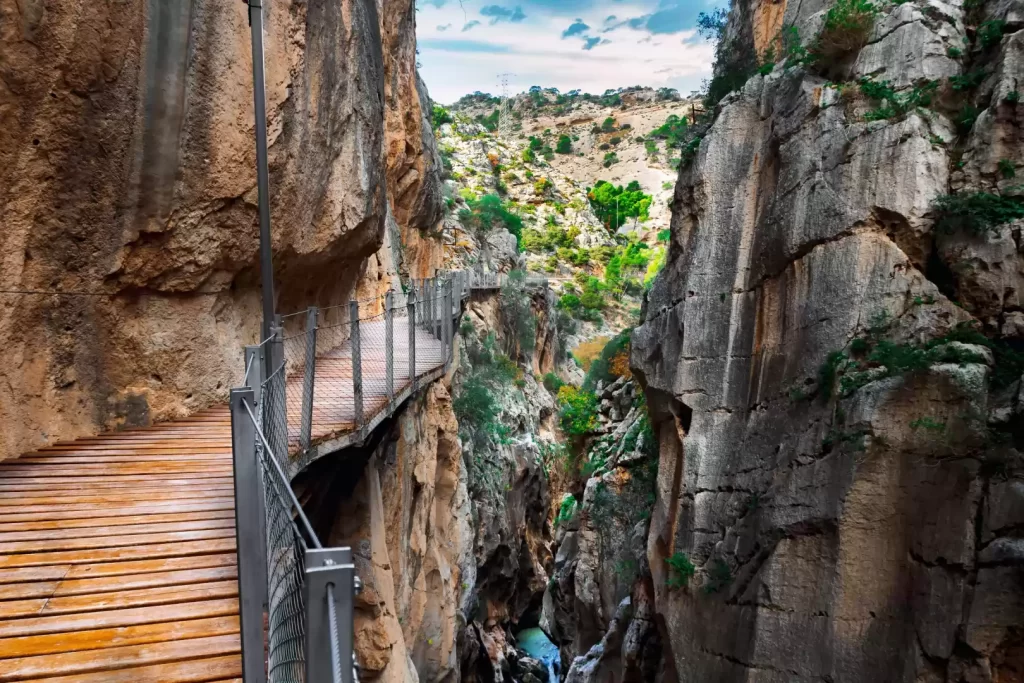Andalusia is home to the enchanting Pueblos Blancos, or White Villages, in the Andalucía (Spain) hills. These villages, with their timeless allure, narrow cobbled lanes, quaint churches, and traditional tapas bars, offer a unique charm to explore. Our guide introduces these charming villages, inviting you to experience the tranquility and peace of traditional Spanish life and to discover the exceptional charm that sets these villages apart.
What are white villages or Pueblos Blancos in Spain?
The White Villages of Spain, with their hilltop locations and often Moorish roots, are a testament to the rich history of the Andalucía region of southern Spain. Their most distinctive feature is a maze of charming, whitewashed buildings with red-tiled roofs. These villages offer a unique connection to the past with their fascinating history and often defensive Moorish castles, quaint churches, and lovely town squares lined with fragrant orange trees. Whether popular tourist locations or traditional Spanish villages, they all have old-school tapas bars, unique characteristics, and stunning views, providing a rich cultural and historical experience.
Where are the White Villages/pueblos Blancos?
The white villages are scattered across Spain, with the most famous ones in the triangle between Málaga, Cádiz, and Seville in Andalucía, in the south. These white villages were under Moorish rule from the 8th to the 15th century. Their strategic hilltop positions preserved the unique architecture of that period.
The blend of historical influences and stunning locations gives the white villages of southern Spain a captivating charm.
Our website includes affiliate links. So, remember that we may receive commissions when you click our links and make purchases. Please read our legal disclaimer document for more information about our Affiliate disclaimer and other disclaimers like the Fair-Use disclaimer.
Is Visiting Pueblos Blancos Worth It?
We had a great time exploring the Pueblos Blancos in southern Spain. One of the highlights was visiting Grazalema, a hotspot for hiking and biking. After exploring the white villages, we headed to Seville, which is an excellent contrast to the rural destinations. Overall, it was a unique experience that we could only have in Spain.
How to see pueblos blancos in Spain?
Tours from Málaga, the Costa del Sol, or Seville can take you to two or three white villages. Day trips from Málaga and the Costa del Sol include Ronda and Setenil de las Bodegas. Trips from Seville include Ronda, Grazalema, and Zahara de la Sierra. Consider renting a car to see more villages.
Itinerary
To fully experience a variety of Spain’s captivating White Villages, we suggest renting a car and exploring the area at your own pace.
You can visit the following villages on a circular driving route in one busy day or over a more relaxed two-day period.
This itinerary will lead you to a diverse selection of villages, each with unique qualities. The route also includes a breathtaking drive over the pass between Zahara and Grazalema, renowned as one of the most scenic drives in Andalucía. From the charming Olvera with its olive groves and rolling hills to the unique Setenil de las Bodegas with its cave-integrated buildings, each village offers a different but equally captivating experience. Olvera, for instance, is known for its church and the reconstructed 12th-century castle that dominates the top of the hill. At the same time, Setenil de las Bodegas is famous for its homes, built into natural caves along the gorge of Trejo River.
While in the area, take advantage of the opportunity to explore the excellent Caminito del Rey. This famous walkway is pinned along the steep walls of a narrow gorge in El Chorro, near Ardales in the province of Málaga. The path is known for its breathtaking views and is a must-visit for adventure enthusiasts.
How many days are enough to visit the White Villages?
Depending on how many different towns you plan to visit and whether you want to enjoy hiking in the area as well—which I highly recommend—I would say that 3-5 nights are ideal. Most towns are small, and you can visit two or more of them in one day. The best times to visit are spring and autumn when the weather is mild and the landscapes are most beautiful. The villages are less crowded during these seasons, and the weather is perfect for outdoor activities.
If you travel to Spain by plane, the ideal plan is to combine a trip to this beautiful Spanish city with a trip to Seville since you will start and end your journey there!

©Romas_Photo/Shutterstock
Our list of the Most Beautiful White Villages/Pueblos Blancos in Spain
Ronda
Ronda is a remarkable town with a deep gorge formed by the El Tajo River. The old town dates back to Islamic times, and its Moorish influence is still visible today. Ronda is famous for bullfighting and has one of the finest bullrings in Spain, the Plaza de Toros. After hiking the Caminito del Rey, we visited Ronda just in time to see the famous arched bridge at sunset. It’s a fantastic town with gorgeous old buildings and winding alleys. We highly recommend staying the night to relax and explore the village.

©max8xam
Setenil De las Bodegas
Setenil de las Bodegas is a unique village in the province of Cadiz, Andalusia, Spain. It features homes built into natural caves along the gorge of Trejo River. The village has a rich history dating back to prehistoric times and played a strategic role during the Muslim occupation of Spain. The name “Setenil” comes from the Latin term “septem nihil,” referring to the seven failed attempts of the Catholic monarchs to recapture the town from the Moors.

©phantom-elmundo.unidadeditorial.es
Olvera
Olvera is a charming town surrounded by olive groves and rolling hills. Its hilltop location offers breathtaking views of the surrounding landscape, and its whitewashed buildings and narrow streets make it a classic example of a traditional White Village in Spain.
The most striking features in Olvera are the church and the reconstructed 12th-century castle that dominates the top of the hill. Less popular with tourists, Olvera is a quiet place to enjoy a glass of local Vermouth, sample traditional tapas, and stroll through the charming, silent streets.

©www.cadizturismo.com
Grazalema
We were excited about visiting Grazalema, mainly because it is in Sierra de Grazalema Natural Park and because we wanted to see more mountain scenery. The drive to Grazalema is full of very windy and narrow roads, and the scenery is stunning. Grazalema suddenly appears high in the mountains after taking a final corner on the narrow mountain road. And it’s gorgeous.
Grazalema had the easiest-to-find parking anywhere on this Pueblos Blanco’s day trip. Near the parking lot is a lookout point where you can look over some farmland. It is highly rural here, with the farmer farming his land by hand below this lookout point. In the center of the village, there are so many gorgeous buildings covered in red geraniums. It’s an excellent place to grab a lunch break because many restaurants have patios.

©www.kayak.co.uk
Mijas
Mijas is a charming town with traditional whitewashed streets thanks to its elevated position. The city leads to a cliff-edge viewpoint with unparalleled views of the Mediterranean.
A thriving leather industry, plenty of charming cafes and craft shops, and numerous small tourist attractions continue to attract many visitors. Between the bustling tourist hotspots of Málaga and Marbella, Mijas can get very busy, often highly so. If you want to avoid the crowds, it’s best to arrive early in the morning when you can stroll the charming streets while they wake up.

©lp-cms-production.imgix.net
Arcos De la Frontera
Arcos de la Frontera is undoubtedly the first stop on the “ruta pueblos blancos,” the route through the white villages of Cadiz.
Sitting on a cliff, this captivating Spanish white village is well-known for its impeccably preserved Moorish architecture. The most impressive sights in the town are the winding alleys, where whitewashed walls are adorned with vibrant tiles and traditional Andalusian flower pots.
Once you’ve ascended to the hilltop, enjoy the breathtaking views and explore the grand medieval castle. This imposing landmark was once a Moorish fortress.
Arcos is best experienced on a road trip across Andalusia or via an exceptional tour from either Jerez or Cadiz.
Travel Tip: After exploring Arcos de la Frontera, consider visiting the nearby winery, Bodega Tesalia. They offer guided tours and tastings on their property, where they produce around 65,000 bottles of the finest red wine every year. It’s a nice place to relax and enjoy after a sightseeing tour.

©KikoStock/Shutterstock
Frigiliana
Frigiliana, a charming white village near Malaga and the Costa del Sol, is famous for its picture-perfect beauty. Colorful flowers adorn the white houses, and winding cobblestone streets lead to stunning coastal viewpoints. Try the sweet wine, Vino de Frigiliana. While the lower parts of the village can get crowded, a short uphill walk will take you to quieter, more picturesque areas. Frigiliana is easily accessible from Malaga, with popular tours often including the nearby coastal town of Nerja.

©elmira.es
Zahara de la Sierra in the Sierra de Grazalema
Zahara de la Sierra in Cadiz province is one of Spain’s most dramatic white villages. The view is breathtaking when arriving as the village tumbles down a cliff with a castle at the top. You’ll find wisteria-filled streets, quaint cobbled lanes, and a bustling plaza inside the ancient walls. There are plenty of cafes and restaurants to choose from, and the main square is a lovely spot to enjoy a coffee or ice cream while people-watching. Zahara offers an unforgettable and highly photogenic experience.

©sientecordoba.com
Iznajar
Iznajar is a photographer’s dream. This picturesque pueblo blanco is located between Granada and Cordoba. Access the village by crossing a bridge over the water reservoir. Take advantage of the viewpoint before the bridge for a stunning panorama of Iznajar reflected in the water. The cobbled streets are filled with white houses adorned with colorful geraniums. The must-see attraction is the castle, offering a beautiful view of olive tree orchards and the reservoir below.

©hayquever.com
Capileira
Capileira, situated above the Poqueira Gorge in mainland Spain, is the second-highest village in the country. Its breathtaking vistas include panoramic views of the snow-capped peaks of the Sierra Nevada mountains, making it a sought-after destination for hikers looking to conquer Mulhacen, the highest summit in continental Spain.
Designated as a national Spanish heritage site, Capileira and its surroundings hold significant artistic and historical value. The village’s architecture, reminiscent of the Moorish Berber style found in Pampaneira, adds to its allure. Capileira is also known for its abundance of freshwater fountains from high mountain areas, adding to its unique charm and appeal.
Pueblos Blancos tours
“You will discover excellent tours listed under the villages and towns above. Each tour has received fantastic reviews, lasts a full day, and is guaranteed to provide an incredible experience.
Here are a few other top-rated options that would make for a perfect day trip from Malaga or Seville:”

©media.vacalia.com
Other places to visit nearby
The White Villages in southern Spain are located in a beautiful and culturally exciting part of the country. Here are some other places to visit in the area.
Caminito del Rey
The Caminito del Rey is a 7-kilometer hike through a stunning gorge suspended 100 meters above the ground on an aerial path. Anyone with a reasonable fitness level can complete the mostly flat trail.
Córdoba
Córdoba was once the capital of the only caliphate in Western Europe. Today, it’s a fascinating city to visit. The Mezquita-Catedral, with its blend of Muslim and Christian influences, is one of the most important buildings in the world. If you want to learn more about visiting Córdoba, check out our guide.
Granada
Granada, situated at the base of the Sierra Nevada mountains, is a town steeped in history. During the Moorish occupation of Spain, it served as a significant center and is particularly renowned for the majestic hilltop fortress, Alhambra. We recommend checking out our informative guide for comprehensive details on visiting Granada.
Málaga
Málaga has been transformed with new urban spaces and has evolved from just a starting point for Spain’s best beaches to a cultural destination in its own right.
Cádiz
Cádiz is an old town by the sea. It has wide roads with large houses and a relaxed feel. The city has a sense of grandeur and Roman history. There are also excellent local tapas bars.
Seville
Seville is the principal city in the Andalusian region. It has excellent art, famous sights, and some of the best food in the area. Learn more in our guide to the best things to do in Seville.
The conclusion
Visiting Andalucia without visiting at least one of the White villages/Pueblos Blancos is incomplete. You simply have to do it if you want to fully understand this beautiful historic land. That’s why we have made our list so you can make your decision easier. However, now it is your turn. Which of the villages has fascinated you the most? If you have any other suggestions, please write them down in the comments below.
Take a look at
References and sources:
Photo credits:
Feature photo credits: Manuel Torres Garcia on Unsplash



